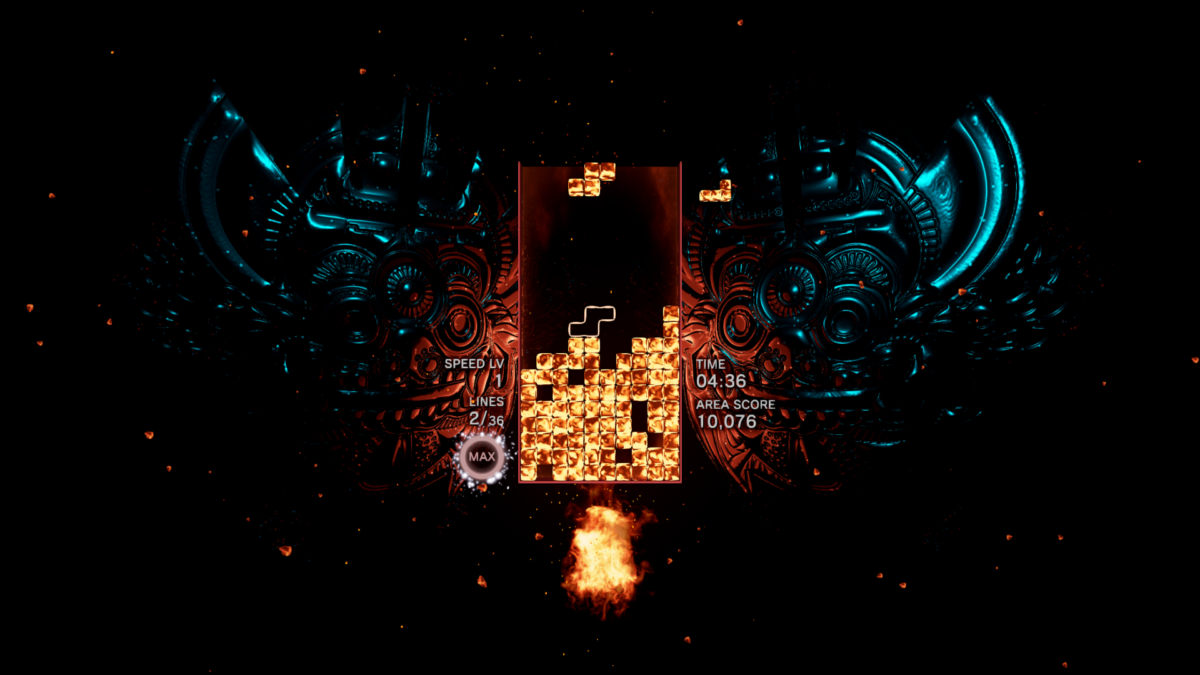Looking for the Quick Review?
Since its original debut in 1988, Tetris has been released no fewer than seventy-nine times on computers, game consoles, phones, and smart TVs. That’s only including official releases. Add in copycats, ripoffs, and fangames, and our number grows. The game’s a cultural mainstay, so much so that its ubiquity is hardly surprising; when I hear that Tetris has been released for a new generation of consoles or a new mobile phone operating system, it feels natural. We’ll always come back to Tetris.
It’s a remarkably simple game. Colored blocks fall, and you try to orient them neatly enough to create perfect lines. Different versions vary in art, music, and gimmicky bonus gamemodes, but they’re all essentially the same; Tetris is Tetris. It’s usually pretty cheap, too. Looking back on EA’s 2008 take on the game for iOS, The Verge called its $9.99 asking price “unheard-of”. Fast forward ten years, Tetris Effect launches at $39.99. So what’s up with that?

Tetris Effect: Connected is Tetris, but it’s not resting on its laurels. At its core, Tetris Effect doesn’t deviate far from the Tetris formula; your goal, in each level, is to use the falling Tetronimos to create neat lines, earning points and progressing for each line you create. There’s an additional “Zone” mechanic which rewards you with points for the lines you finish in a short amount of time, but that’s probably the biggest change to the formula itself; everything else is in the background.
But for Tetris Effect, “background” is a massive understatement. In Journey Mode, the game’s primary campaign-style succession of stages, each individual level is an independently-designed holistic experience, inextricably combining music, art, and gameplay to form a more complete and satisfying whole. Earlier levels feature calmer, ambient tracks that build slowly with the game’s speed; later stages accompany more chaotic background music with rapid changes in the pace of play and a visual style that conveys that sense of urgency without distracting from the puzzle field itself.

Written out like this, it sounds like this is much ado about Tetris, and to some, it probably is; if you haven’t enjoyed the game in the past, Tetris Effect doesn’t add anything to its core loop that’ll change your mind. But if you’re even a casual fan of the game, moving forward, Tetris Effect might be the definitive way to play.
Beyond the game’s core Journey Mode, there are a few alternative single player and multiplayer game modes, each conveying a different challenge. The variability between these modes is limited, and most are pretty similar to the base game or to the multiplayer Tetris you played a decade ago.
The standout mode is Connected, of “in the title” fame. Newly introduced for the game’s Xbox and PC launch, Connected mode is a cooperative challenge where three players work together to defeat an A.I. boss character. The bosses utilize unique powers to sabotage your gameplay, from preventing tetronimo rotation and blocking off columns to replacing tetronimos with five-block pentominos and hiding the entire puzzle field from view.

To combat each of these bosses, the three players build their collective score until they’ve accumulated enough points to connect their three screens together and take turns placing tetronimos cooperatively on a combined field. Completing lines together in this mode adds lines to the bottom of the boss’s playspace, giving them less wiggle room for failure and ratcheting up the difficulty. When one boss’s field fills up, players progress onto the next. The challenge of the mode is surviving all of the attacks from a series of three bosses without losing. It’s a simple enough concept, but the latter levels are surprisingly tough, and some of the more complex attacks require strategic adaptation (or considerable luck) to outlast.
Alone, Tetris Effect is a beautiful and relaxing experience that kept me comfortably entertained for a couple evenings. Together with a friend or two, it’s a compelling and challenging piece of gaming where levels are difficult, but not frustrating. My girlfriend and I still haven’t been able to beat level 5 of Connected, but as long as late quarantine nights on Discord exist, we’ll keep coming back.

Quick Review
Game: Tetris Effect: Connected
Developer: Monstars, Resonair, Stage Games
Published by: Enhance Games
Available for: Windows PC, Xbox One, Xbox Series X/S; Coming Later to Oculus Quest, Playstation 4
CONTENT
Microtransactions: None
Tedium: None
Violence: None
Content: Photosensitivity: frequent flashing lights
FEATURES
- Classic Tetris gameplay
- Variety of stages with vibrant, colorful backdrops and dynamic music that changes with gameplay
- Unique cooperative gamemode

WHAT I LIKED
- It’s Tetris
- Beautiful background art and music makes for a relaxing gameplay experience
- (Couch) Co-op Connected mode is an entertaining challenge that doesn’t lead to frustration
CONCERNS
- Replayability is dependent on how much you enjoy the Tetris gameplay loop
- Changes in the background could be distracting for some; consider checking out gameplay video before purchasing.
- Bright, flashing lights and rapidly-changing background environments could be harmful for the photosensitive.

WHO’S IT FOR?
If you’re a fan of Tetris or simple but challenging puzzle games, and the idea of enjoying a classic video game through a dynamic, artistically-explorative lens sounds compelling to you, Tetris Effect is definitely worth a shot.
If you prefer minimalistic puzzle experiences, have issues with photosensitivity, or don’t like Tetris, this one’s skippable.
